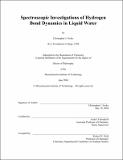| dc.contributor.advisor | Andrei Tokmakoff. | en_US |
| dc.contributor.author | Fecko, Christopher J., 1975- | en_US |
| dc.contributor.other | Massachusetts Institute of Technology. Dept. of Chemistry. | en_US |
| dc.date.accessioned | 2005-05-17T14:48:20Z | |
| dc.date.available | 2005-05-17T14:48:20Z | |
| dc.date.copyright | 2004 | en_US |
| dc.date.issued | 2004 | en_US |
| dc.identifier.uri | http://hdl.handle.net/1721.1/16652 | |
| dc.description | Thesis (Ph. D.)--Massachusetts Institute of Technology, Dept. of Chemistry, 2004. | en_US |
| dc.description | MIT Institute Archives copy: pages 215 to 304 bound in reverse order. | en_US |
| dc.description | Includes bibliographical references. | en_US |
| dc.description | This electronic version was submitted by the student author. The certified thesis is available in the Institute Archives and Special Collections. | en_US |
| dc.description.abstract | Many of the remarkable physical and chemical properties of liquid water are due to the strong influence hydrogen bonds have on its microscopic dynamics. However, because of the fast timescales involved, there are relatively few experimental techniques capable of directly probing rearrangements of water's hydrogen bonded network. In this thesis, I investigate ultrafast intermolecular dynamics of water with time-resolved Raman and time-resolved infrared spectroscopies. These two sets of measurements provide a complimentary view of the collective and local behavior of molecular motions. Using a novel Raman technique, spatially masked optical Kerr effect spectroscopy, I first measured interaction-induced fluctuations in the isotropic many-body polarizability of water and several other liquids. In contrast to the behavior of simple liquids, the isotropic response of water is exceedingly fast and distinct from the well-known anisotropic response. I then designed and built an optical parametric amplifier that produces sub-50 fs pulses of mid-IR light to investigate the intermolecular dynamics of water through their effect on the OH oscillator of HOD in D20. By analyzing the results of three-pulse vibrational echo and polarization- selective pump-probe measurements with a comprehensive theory to describe vibrational dynamics, I extracted the timescales for vibrational relaxation, dephasing and molecular reorientations. | en_US |
| dc.description.abstract | (cont.) At short times, vibrational dephasing reflects an underdamped 180 fs hydrogen bond oscillation, but the long time behavior indicates collective structural reorganization of the hydrogen bond network a 1.4 ps timescale. The anisotropy decays on timescales of 50 fs and 3 ps, which are attributed to librations and rotational diffusion, respectively. Lastly, I used two-dimensional infrared spectroscopy to investigate the frequency dependence of the dynamics. Preliminary results reflect a distribution of timescales for both local motion and collective reorganization. | en_US |
| dc.description.statementofresponsibility | by Christopher J. Fecko. | en_US |
| dc.format.extent | 304 p. | en_US |
| dc.format.extent | 4040091 bytes | |
| dc.format.extent | 8282213 bytes | |
| dc.format.mimetype | application/pdf | |
| dc.format.mimetype | application/pdf | |
| dc.language.iso | eng | en_US |
| dc.publisher | Massachusetts Institute of Technology | en_US |
| dc.rights | M.I.T. theses are protected by copyright. They may be viewed from this source for any purpose, but reproduction or distribution in any format is prohibited without written permission. See provided URL for inquiries about permission. | en_US |
| dc.rights.uri | http://dspace.mit.edu/handle/1721.1/7582 | |
| dc.subject | Chemistry. | en_US |
| dc.title | Spectroscopic investigations of hydrogen bond dynamics in liquid water | en_US |
| dc.type | Thesis | en_US |
| dc.description.degree | Ph.D. | en_US |
| dc.contributor.department | Massachusetts Institute of Technology. Department of Chemistry | |
| dc.identifier.oclc | 56473918 | en_US |
